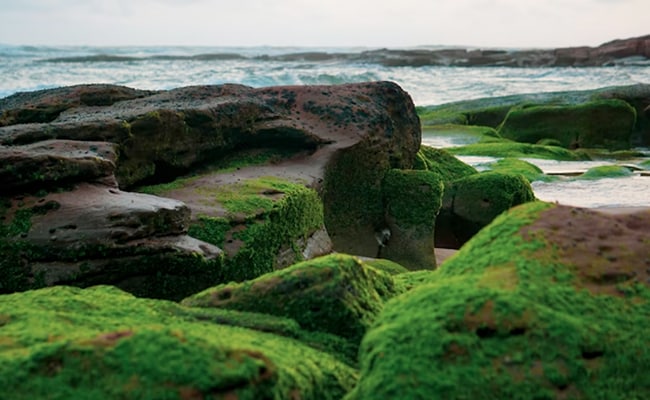Harmful Algal Bloom Threatens California's Coastal Wildlife

Table of Contents
Understanding Harmful Algal Blooms (HABs) in California
What are HABs?
Harmful algal blooms are rapid increases in the population of certain algae species in water bodies. These blooms aren't all harmful; however, some species produce toxins that can have severe consequences for marine life and even humans. The algae involved in HABs include dinoflagellates (like Alexandrium catenella, responsible for paralytic shellfish poisoning) and diatoms. These microscopic organisms release potent toxins into the water.
- HAB Formation: HABs form when specific environmental conditions align, creating a breeding ground for toxin-producing algae. This includes:
- Abundant nutrients (nitrogen and phosphorus) from runoff, often stemming from agricultural fertilizers and urban wastewater.
- Warm water temperatures.
- Sufficient sunlight for photosynthesis.
- Stable water column conditions.
The Impact of HABs on California's Water Quality
HABs significantly degrade California's water quality. The dense concentration of algae can lead to oxygen depletion (hypoxia) in the water, creating "dead zones" where marine life cannot survive. Furthermore, the toxins released by these algae pose a direct threat.
- Harmful Toxins: HABs produce various toxins, including:
- Domoic acid: Neurotoxin that causes amnesic shellfish poisoning (ASP).
- Brevetoxins: Neurotoxins associated with neurotoxic shellfish poisoning (NSP).
- Saxitoxins: Neurotoxins causing paralytic shellfish poisoning (PSP).
These toxins accumulate in shellfish and other organisms, impacting human health if consumed. Moreover, the presence of HABs often necessitates the closure of beaches and shellfish harvesting areas, impacting recreational activities and the economy.
Devastating Effects on California's Coastal Wildlife
Impacts on Marine Mammals
California's marine mammals, including sea lions, whales, and dolphins, are highly vulnerable to HABs. Ingestion of contaminated prey or direct exposure to toxins can lead to severe illness and death.
- HAB-related Mortality: Numerous instances of marine mammal strandings and deaths have been linked to HABs. Symptoms include neurological problems, seizures, and respiratory distress.
- Reproductive Issues: Exposure to HAB toxins can negatively impact reproductive success in marine mammals, leading to decreased birth rates and impaired offspring development.
Impacts on Seabirds and Fish
The impact of HABs extends to seabirds and fish populations. Toxins bioaccumulate in the food chain, meaning smaller organisms absorb toxins, which then concentrate as they are consumed by larger predators. This process, known as biomagnification, leads to higher toxin concentrations at higher trophic levels.
- Bioaccumulation & Biomagnification: Fish consuming algae with domoic acid can accumulate high levels, making them unsafe for human consumption and harming predators that consume them.
- Population Decline: HABs can cause significant declines in fish populations, affecting the entire marine food web and impacting commercially important species.
Impacts on Shellfish and Invertebrates
Shellfish, like mussels and clams, are particularly susceptible to HAB toxins, as they filter-feed on algae. This directly impacts their health and can cause shellfish poisoning in humans who consume them.
- Shellfish Poisoning: Paralytic Shellfish Poisoning (PSP) is a severe form of shellfish poisoning caused by saxitoxins. It can lead to respiratory paralysis and even death.
- Economic Impacts: HAB outbreaks often lead to closures of shellfish beds, resulting in significant economic losses for the shellfish industry and coastal communities.
Monitoring and Mitigation Strategies for HABs in California
Current Monitoring Efforts
Several state and federal agencies actively monitor HABs in California, employing a range of techniques.
- Satellite Imagery: Provides a broad overview of bloom locations and extent.
- Water Sampling: Used to identify the specific algae species present and measure toxin levels.
- Early Warning Systems: Help to predict and alert the public to potential HAB events.
Key agencies involved include the California Department of Fish and Wildlife (CDFW), the National Oceanic and Atmospheric Administration (NOAA), and various research institutions.
Mitigation and Prevention
Reducing the frequency and severity of HABs requires a multi-pronged approach.
- Nutrient Runoff Reduction: Implementing sustainable agricultural practices and improving wastewater treatment are crucial to minimizing nutrient inputs into coastal waters.
- Improved Water Quality: Protecting and restoring coastal wetlands and estuaries can enhance water quality and reduce the likelihood of HAB formation.
- Research & Technology: Investing in research to better understand HAB dynamics, develop early warning systems, and explore potential mitigation technologies is essential.
- Public Awareness: Educating the public about HAB risks and safe practices during blooms is crucial for protecting human and environmental health.
Conclusion
Harmful algal blooms pose a serious and escalating threat to California's coastal wildlife and the health of its marine ecosystem. The devastating impacts on marine mammals, seabirds, fish, shellfish, and the overall food web highlight the urgent need for action. The economic consequences of HABs on the shellfish industry and recreational activities further emphasize the severity of this issue. We must learn more about harmful algal blooms and their impact, stay informed about HAB advisories, and actively support efforts to protect our oceans and coastal wildlife from the continued threat of harmful algal blooms. Let's contribute to initiatives aimed at reducing nutrient runoff and promoting sustainable coastal management practices to safeguard California's precious coastal environment for future generations.

Featured Posts
-
 Experience Gorillaz House Of Kong Exhibition At Londons Copper Box Arena
May 30, 2025
Experience Gorillaz House Of Kong Exhibition At Londons Copper Box Arena
May 30, 2025 -
 Pasxalines T Heia Leitoyrgies And Ekdiloseis Tileoptiko Programma E Thessalia Gr
May 30, 2025
Pasxalines T Heia Leitoyrgies And Ekdiloseis Tileoptiko Programma E Thessalia Gr
May 30, 2025 -
 Ticketmaster Y Setlist Fm Planifica Tu Experiencia Musical Perfecta
May 30, 2025
Ticketmaster Y Setlist Fm Planifica Tu Experiencia Musical Perfecta
May 30, 2025 -
 Enjoy Four Days Of Warm Sunny Weather In San Diego County
May 30, 2025
Enjoy Four Days Of Warm Sunny Weather In San Diego County
May 30, 2025 -
 Kyriaki 16 3 Odigos Tileoptikon Programmaton
May 30, 2025
Kyriaki 16 3 Odigos Tileoptikon Programmaton
May 30, 2025
Latest Posts
-
 Dont Miss Out 30 Off Lavish Hotels This Spring
May 31, 2025
Dont Miss Out 30 Off Lavish Hotels This Spring
May 31, 2025 -
 Up To 30 Off Lavish Spring Hotel Bookings
May 31, 2025
Up To 30 Off Lavish Spring Hotel Bookings
May 31, 2025 -
 Book Now And Save 30 Off Lavish Spring Hotel Stays
May 31, 2025
Book Now And Save 30 Off Lavish Spring Hotel Stays
May 31, 2025 -
 Spring Hotel Sale Get 30 Off Your Lavish Stay
May 31, 2025
Spring Hotel Sale Get 30 Off Your Lavish Stay
May 31, 2025 -
 Luxury Hotel Spring Sale 30 Discount
May 31, 2025
Luxury Hotel Spring Sale 30 Discount
May 31, 2025
